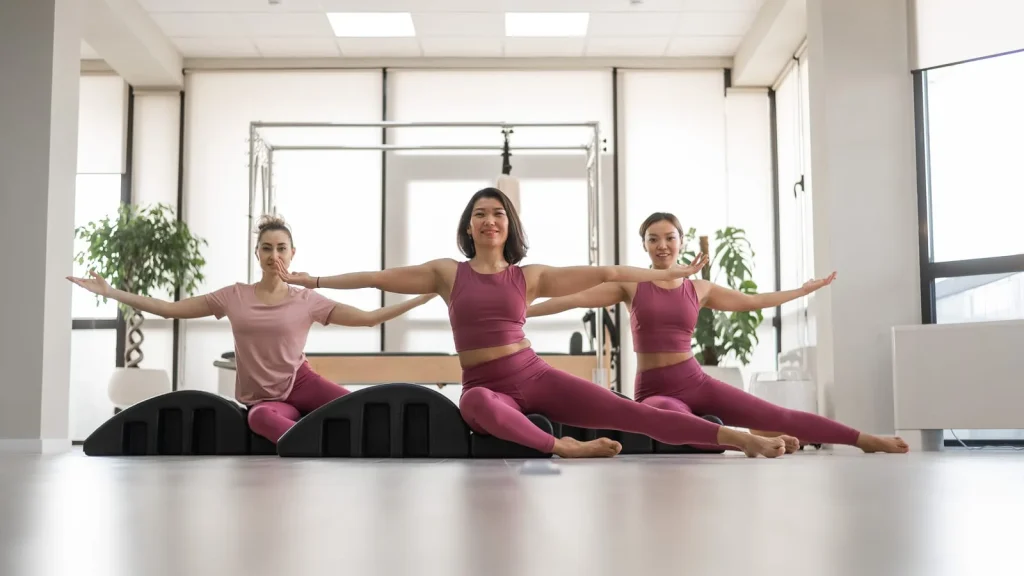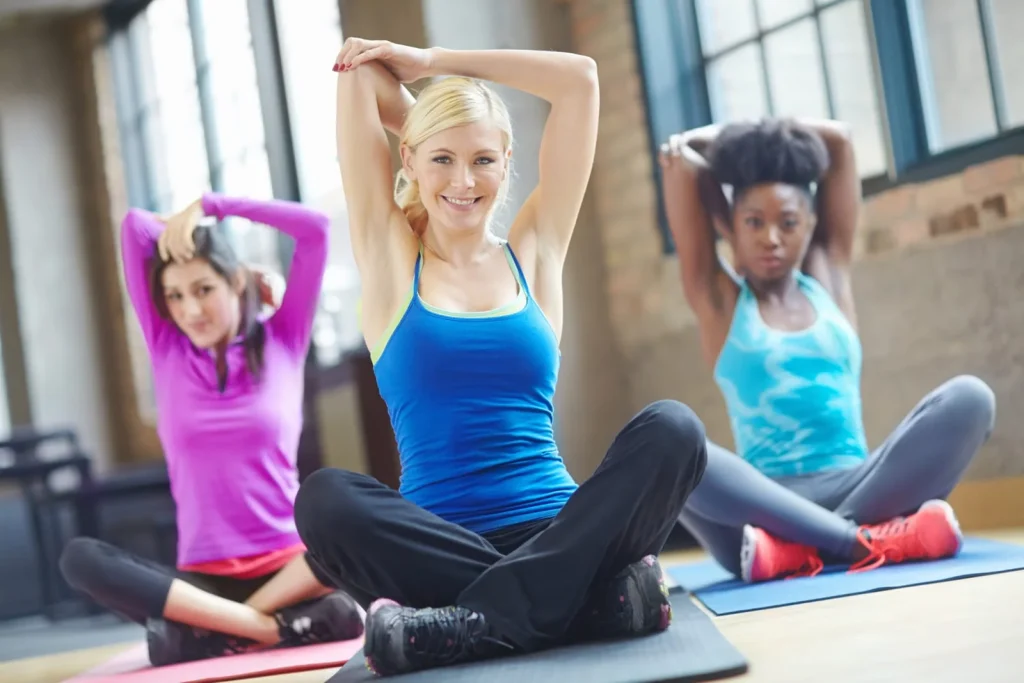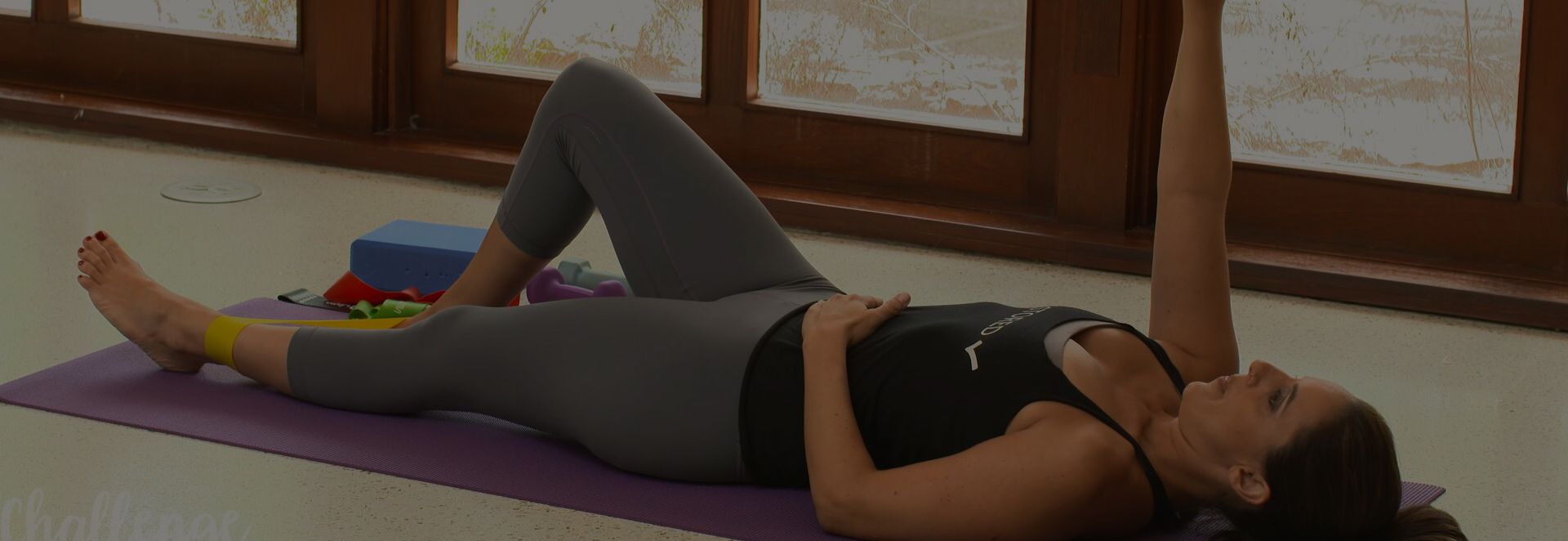Resources
- The Connection Between Exercise and Bloating: What Every Professional (and Their Clients) Need to Know
- How to Strengthen Pelvic Floor Safely
- Pelvic Floor Exercises for Constipation: Awareness, Movement, and Nervous System Relief
- High-Tone Pelvic Floor Dysfunction: Symptoms, Causes & Relief Tips
- How Menopause Affects the Pelvic Floor: Symptoms, Support & Hormonal Impact
- Tailbone Wagging for Tailbone Pain Relief and Pelvic Floor Mobility
- The Power of Tremoring: How Tension Release Exercises Support Your Nervous System
- Pelvic Floor Postpartum Exercises for Faster Recovery
- Navigating Coccyx Pain in Pregnancy: A Trimester-by-Trimester Guide
- Understanding Coccyx Pain: Symptoms, Causes, Healing and Prevention
- Pilates and Pelvic Floor Dysfunction: Is It the Solution You’re Seeking?
- 5 Pilates Pelvic Floor Exercises You Don’t Want to Leave Out
- Pelvic Floor Massage: A Comprehensive Guide
- Hypermobility and Pelvic Floor Health: What You Need to Know
- The Foot to Pelvic Floor Connection: A Whole-Body Approach to Movement and Health
- Understanding Pelvic Floor Pain After Running: Causes and Solutions for Professionals
- Top 5 Exercises to Strengthen the Pelvic Floor
- Do Squats Strengthen Pelvic Floor Muscles? Insights for Movement Professionals
- How Pelvic Floor Health Is Related to the Process of Moving from Arousal to Orgasm
- 5 Things I Wish People Knew About Your Pelvic Floor & Orgasm
- Pelvic Floor Tension: Everything You Need to Know
- How Running and Pelvic Floor Health Are Interconnected: What Every Runner Should Know
- Does Running Strengthen Pelvic Floor Muscles? Myths vs. Facts
- Understanding Urine Leakage Causes: Why It Happens and How to Manage It
- How to Strengthen Your Pelvic Floor: The Ultimate Guide
- Strengthening and Restorative Yoga Poses for Full Body Health
- Understanding Queefing: Causes, Symptoms, and Simple Prevention Tips
- How Do You Know if You Have a Weak Pelvic Floor
- What Does Pelvic Floor Pain Feel Like?
- How Can I Strengthen My Pelvic Floor Without Kegels?
- Pelvic Floor Stretches | 5 Quick Ways To Relax Your Pelvis
- Pelvic Floor Specialist | Finding Help To Heal Your Pelvis
- Is Pelvic Floor Repair Major Surgery? | Pelvic Health Guide
- Pelvic Floor Exercise
- How to Strengthen Pelvic Floor
- Pelvic Floor Therapy | Improving Your Pelvic Health
Resources
- The Connection Between Exercise and Bloating: What Every Professional (and Their Clients) Need to Know
- How to Strengthen Pelvic Floor Safely
- Pelvic Floor Exercises for Constipation: Awareness, Movement, and Nervous System Relief
- High-Tone Pelvic Floor Dysfunction: Symptoms, Causes & Relief Tips
- How Menopause Affects the Pelvic Floor: Symptoms, Support & Hormonal Impact
- Tailbone Wagging for Tailbone Pain Relief and Pelvic Floor Mobility
- The Power of Tremoring: How Tension Release Exercises Support Your Nervous System
- Pelvic Floor Postpartum Exercises for Faster Recovery
- Navigating Coccyx Pain in Pregnancy: A Trimester-by-Trimester Guide
- Understanding Coccyx Pain: Symptoms, Causes, Healing and Prevention
- Pilates and Pelvic Floor Dysfunction: Is It the Solution You’re Seeking?
- 5 Pilates Pelvic Floor Exercises You Don’t Want to Leave Out
- Pelvic Floor Massage: A Comprehensive Guide
- Hypermobility and Pelvic Floor Health: What You Need to Know
- The Foot to Pelvic Floor Connection: A Whole-Body Approach to Movement and Health
- Understanding Pelvic Floor Pain After Running: Causes and Solutions for Professionals
- Top 5 Exercises to Strengthen the Pelvic Floor
- Do Squats Strengthen Pelvic Floor Muscles? Insights for Movement Professionals
- How Pelvic Floor Health Is Related to the Process of Moving from Arousal to Orgasm
- 5 Things I Wish People Knew About Your Pelvic Floor & Orgasm
- Pelvic Floor Tension: Everything You Need to Know
- How Running and Pelvic Floor Health Are Interconnected: What Every Runner Should Know
- Does Running Strengthen Pelvic Floor Muscles? Myths vs. Facts
- Understanding Urine Leakage Causes: Why It Happens and How to Manage It
- How to Strengthen Your Pelvic Floor: The Ultimate Guide
- Strengthening and Restorative Yoga Poses for Full Body Health
- Understanding Queefing: Causes, Symptoms, and Simple Prevention Tips
- How Do You Know if You Have a Weak Pelvic Floor
- What Does Pelvic Floor Pain Feel Like?
- How Can I Strengthen My Pelvic Floor Without Kegels?
- Pelvic Floor Stretches | 5 Quick Ways To Relax Your Pelvis
- Pelvic Floor Specialist | Finding Help To Heal Your Pelvis
- Is Pelvic Floor Repair Major Surgery? | Pelvic Health Guide
- Pelvic Floor Exercise
- How to Strengthen Pelvic Floor
- Pelvic Floor Therapy | Improving Your Pelvic Health
Does Pilates Strengthen Pelvic Floor Muscles? A Comprehensive Guide
By Lauren Ohayon 10/31/2024
6 Min Read
The pelvic floor is a hot topic in the world of fitness and therapeutic work. We know it’s crucial for supporting the pelvic organs, controlling the sphincters, enhancing sexual function, and providing a stable base for the spine and pelvis. Despite its importance, the pelvic floor remains a bit of a mystery and I am often asked, “What are safe forms of exercise to help strengthen the pelvic floor?”
Table of Contents
There are many answers to that question. One of them is Pilates!
The Pilates method is a form of exercise developed in the early 1900’s by a German movement trainer named Joseph H. Pilates. Pilates (formerly called Contrology) builds strength and flexibility throughout the body, beginning with a foundation of strong core muscles. The pelvic floor muscles are one of four groups of muscles that comprise the “core.”

So, how does Pilates strengthen the pelvic floor?
Pilates strengthens the pelvic floor through specific exercises, either on the mat or using specific equipment, which focus on building core strength, stability, flexibility and alignment.
Here’s how it works:
- Core Engagement: The foundation of Pilates is performing specific exercises to activate the deep core muscles, particularly the transversus abdominis, multifidus, diaphragm and pelvic floor. The deep abdominals are connected to the pelvic floor, so strengthening the core helps build strength and control in the pelvic region.
- Breath Control: Pilates incorporates breath awareness, promoting relaxation and proper timing and contraction of the abdominals, and thus pelvic floor muscles, during movements.
- Targeted Exercises: Pilates promotes slow, controlled movements, which enhance muscle engagement and stability. This controlled approach helps strengthen the core while minimizing the risk of injury. Many Pilates exercises, such as pelvic curls, side lying leg work, seated movements and bridge variations, specifically encourage awareness and control of the core muscles. There are also more dynamic movements in Pilates, such as rolling and planking, which require core strength to support the spine and maintain stability while in motion. Many Pilates exercises also challenge balance, forcing the body to engage the core muscles to maintain proper alignment and control.
- Alignment and Posture: Pilates promotes awareness of alignment and balanced muscle loading, which can help reduce pressure on the pelvic floor and improve overall function.
- Mind-Body Connection: The focus on mindful movement in Pilates helps individuals become more aware of their movement patterns, breathing strategies, strength and coordination.
So, how do you practice Pilates?
There are many options for Pilates these days, ranging from boutique Pilates studios to gym and fitness facilities to online programs and YouTube. Here are some steps to get you going:
- Research Basics: Familiarize yourself with Pilates principles. It focuses on controlled movements, core strength, and breathing.
- Choose a Style: There are various forms of Pilates, including Mat Pilates and Reformer and Apparatus Pilates. Mat Pilates uses a mat and minimal equipment, while Reformer and Apparatus Pilates use specialized equipment to offer resistance and assistance to movement.
- Find a Class or Instructor: Look for local studios offering Pilates classes. It’s helpful to start with a beginners’ class to learn the fundamentals. You can also find online classes if you prefer to start at home.
- Wear Comfortable Clothing: Dress in comfortable, breathable clothes that allow for movement. Avoid bulky clothing that could get in the way.
- Start Slow: Beginner classes are a great way to build a solid foundation. Focus on learning the correct form and techniques to get the most out of the exercises. Restore Your Core® is also a wonderful supplement to beginning your Pilates practice.
- Listen to Your Body: Pay attention to how your body feels during and after workouts. It’s important to push yourself, but not to the point of pain.
- Consider Private Sessions: If you’re feeling uncertain, a few private lessons with a qualified instructor can help you get personalized feedback and guidance.
As you progress, you can explore more advanced classes and variations.
Strengthening the pelvic floor is just one of the many benefits of Pilates. Here’s a simple routine you can follow to target that area:

Pelvic Floor Strengthening Pilates Routine
1. Pelvic Tilts
- How to do it: Lie on your back with knees bent and feet flat on the floor, hip-width apart. Inhale to prepare, then exhale as you tilt your pelvis, flattening your lower back into the mat. Inhale to return to neutral.
- Repetitions: 8-10 times.
2. Bridge
- How to do it: From the same starting position, exhale and press into your heels, curl your pelvis into a tilt by flattening your back to the floor, and roll your hips up towards the ceiling. Inhale at the top, then exhale as you roll back down.
- Repetitions: 8-10 times.
3. Marching
- How to do it: Lie on your back with your knees bent. Engage your core as you fold one knee towards your chest, keeping your back neutral and pelvis level (ie, you want the natural curve of your lumbar spine here, don’t flatten your back to the floor or allow your pelvis to shift). Lower your foot to the floor and switch sides.
- Repetitions: 8-10 marches on each leg.
4. Modified Side Plank
- How to do it: Start on your side with your forearm on the mat, knees bent. As you exhale, lift your hips off the mat. Make sure your core feels like it’s lifting up inside of you on the exhale rather than bearing down. Hold for 10-15 seconds, then lower.
- Repetitions: 3-5 times on each side.
5. Tabletop Leg Lifts
- How to do it: On all fours, ensure your back is long and your pelvis is neutral. Exhale to engage your core as you reach one leg back to hip height, straightening your knee. Lower back down and switch legs. Don’t allow your body to shift from side to side, or you won’t feel it in your core.
- Repetitions: 8-10 lifts on each side.
6. Child’s Pose
- How to do it: Kneel and sit back on your heels, reaching your arms forward. Breathe deeply, relaxing your pelvic floor. Hold for 30 seconds to 1 minute.
Tips:
- Focus on your breath—use Candles Breathing to support a responsive core when moving through the exercises: imagine a birthday cake with 100 candles on it in front of you, and slowly blow out the candles to feel the deep/lower core contract. You’ll feel a corseting or narrowing across your lower abdomen. This will help activate your core as you move.
- Keep movements controlled and avoid straining, bulging or bearing down in your lower abdominals/pelvic region.
- The pelvic floor muscles should not be tight or engaged all the time. Take opportunities to soften the muscles when you’re in relaxed positions like when you’re lying down, meditating or reading a book.
- Aim to practice this routine 2-3 times a week for best results.
If you’re looking for a program that specifically integrates these principles into a comprehensive fitness routine, Restore Your Core® is an excellent option. This program focuses on building functional core strength, pelvic floor awareness, and alignment in a way that is safe and supportive for individuals at all stages of life. It incorporates many alignment strategies, breath control, and core engagement, which are discussed here, offering a well-rounded approach to pelvic floor health.
Here are some helpful tips for Pilates beginners to ensure you get the most out of your practice:
1. Start with a Class
- Consider taking a beginner class with a certified instructor. This helps you learn the fundamentals and ensures you use proper form.
2. Focus on Form
- Quality over quantity! Concentrate on performing each movement correctly rather than rushing through repetitions.
3. Breathe Deeply
- Proper breathing is essential in Pilates. Inhale deeply through your nose and exhale through your mouth, coordinating your breath with your movements.
4. Engage Your Core
- Your core is designed to be responsive to movement. Notice your core engaged when moving your body. If you’re not sure, return to the practice of pretending to blow out candles (ie. Candles Breath) when you’re preparing to move your body in different ways.
5. Listen to Your Body
- Pay attention to how your body feels. If something doesn’t feel right, modify the exercise or take a break.
6. Use Props Wisely
- Don’t hesitate to use props like blocks, straps, or a reformer (if available) to help you achieve the correct alignment and support your practice.
7. Stay Consistent
- Aim to practice regularly—2 to 3 times a week is a good starting point. Consistency helps build strength and flexibility over time.
8. Warm Up and Cool Down
- Always take time to warm up before starting and cool down afterward to help prevent injury.
9. Hydrate
- Drink water before and after your session to stay hydrated, but avoid drinking too much during your workout.
Remember, everyone progresses at their own pace, so celebrate your small victories along the way!
If you’re an advanced Pilates student, here are some tips to enhance your practice and continue progressing:
1. Focus on Precision
- Concentrate on the quality of each movement. Fine-tune your form and alignment, ensuring you’re executing exercises with precision.
2. Explore Advanced Variations
- Challenge yourself with more complex variations of traditional exercises. Incorporate movements that require greater strength, balance, and coordination.
3. Incorporate Breath Control
- Master the integration of breath with movement. Use your breath to deepen your engagement and enhance the effectiveness of your workouts.
4. Add Resistance
- Utilize heavier resistance on the reformer or incorporate props like resistance bands or weights to further challenge your strength.
5. Focus on Transitions
- Pay attention to the transitions between exercises. Smooth, controlled transitions can improve flow and demonstrate mastery of your practice.
6. Incorporate Functional Movement
- Integrate functional movements that mimic real-life activities. This can enhance strength and balance in daily tasks.
7. Work on Stability and Control
- Challenge your stability with exercises that require balance and control, such as single-leg or plank variations.
8. Engage in Cross-Training
- Consider adding other forms of exercise, such as yoga, dance, or strength training, to complement your Pilates practice and enhance overall fitness.
9. Reflect on Your Goals
- Regularly reassess your goals and progress. Set new challenges for yourself to keep your practice fresh and engaging.
10. Teach Others
- Sharing your knowledge with beginners or assisting in classes can deepen your understanding and enhance your own practice.
11. Listen to Your Body
- Even at an advanced level, paying attention to how your body feels is crucial. Modify exercises as needed and allow time for recovery.
12. Stay Curious
- Continuously seek out new learning opportunities, whether through workshops, advanced classes, or reading about Pilates techniques and philosophies.
By integrating these tips into your routine, you can continue to advance your skills and enjoy the benefits of a more profound Pilates practice!
Improving pelvic floor strength is a journey! Be patient with yourself and take the time to enjoy the improvements in strength, flexibility, and body awareness over time. Consistent practice, whether through Pilates or a program like Restore Your Core®, can help build pelvic floor strength, which is essential for overall pelvic health.
FAQ
1. How often should I practice Pilates to strengthen my pelvic floor?
Ideally, three days per week is recommended. But any Pilates practice is helpful, even if once per week.
2. Can Pilates alone resolve pelvic floor disorders?
No, Pilates will likely not resolve pelvic floor disorders on its own. However, Pilates is a fantastic supplement to a multi-faceted approach, which may include bodywork, pelvic floor physical therapy, and other modalities.
3. What are the signs of pelvic floor strengthening progress with Pilates?
Stronger core. Decreased back and/or hip discomfort. Less “sneeze pee” or leaking.
4. Are there any Pilates exercises I should avoid if I have pelvic floor dysfunction?
If you currently have symptoms of pelvic floor dysfunction, avoiding heavily loaded abdominal exercises such as The Hundred, Series of Five, Rollover and Teaser may be necessary. Working with a qualified Pilates instructor who understands pelvic floor dysfunction could offer great benefit.
5. Can Pilates improve sexual health through pelvic floor strengthening?
Many individuals have experienced increased sexual health while on a pelvic floor strengthening program. Pilates may offer improvement in this area.
6. How do I modify Pilates exercises as my pelvic floor strength improves?
Pilates can be practiced with many modifications and variations. Working with a qualified instructor will help you gain the most benefit from the exercises at every stage of the pelvic floor strengthening journey.



